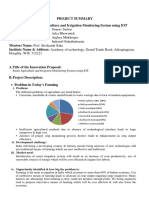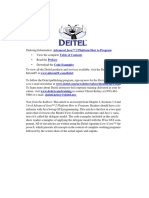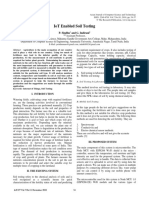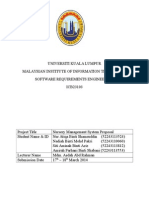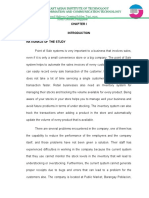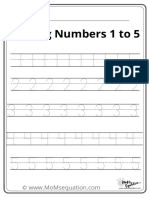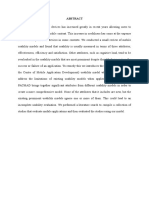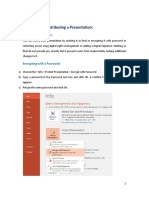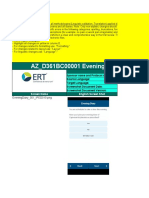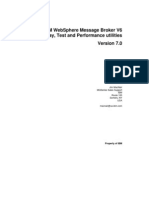Professional Documents
Culture Documents
Agro-Genius: Crop Prediction Using Machine Learning
Original Title
Copyright
Available Formats
Share this document
Did you find this document useful?
Is this content inappropriate?
Report this DocumentCopyright:
Available Formats
Agro-Genius: Crop Prediction Using Machine Learning
Copyright:
Available Formats
Volume 4, Issue 10, October – 2019 International Journal of Innovative Science and Research Technology
ISSN No:-2456-2165
Agro-Genius: Crop Prediction using Machine Learning
Thayakaran Selvanayagam1, Suganya S2, Puvipavan Palendrarajah3
Mithun Paresith Manogarathash4, Anjalie Gamage5, Dharshana Kasthurirathna6
Faculty of Computing, Sri Lanka Institute of Information Technology (SLIIT)
Malabe, Sri Lanka.
Abstract:- This paper present a way to aid farmers crops. Also, the main issue that small farmers are currently
focusing on profitable vegetable cultivation in Sri Lanka. facing is that, they sow the crops according to their own
As agriculture creates an economic future for developing experiences. But when they are cultivating and bringing them
countries, the demand of modern technologies in this to market, they face difficulties to market their product at a
sector is higher. Key technologies used for this problem reasonable price. It is because of large farms cultivating the
are Deep Learning, Machine Learning and Visualization. same. As our country is small, products are distributed all
As the product, an android mobile application is over the country in between Districts (Dambulla to Jaffna,
developed. In this application the users should input their Dambulla to Petra, etc.). Because of this, small-scale rural
location to start the prediction process. Data farmers affected economically.
preprocessing is started when the location is received to
the system. The collected dataset divided into 3 parts. 80 Nowadays weather condition is not like previous
percent for training, 10 percent for testing and 10 percent decades. Day by day it is changing because of the
for validation. After that the model is created using LSTM globalization, so farmers have faced difficulties to predict
RNN for vegetable prediction and ARIMA for price weather conditions. They may be some natural disaster which
prediction. Finally, for given location profitable crop and can also affects cultivation in a sudden. Without the weather,
predicted future price of vegetables are shown in the there are some major factors such as seasonal crop details,
application. Other than the prediction, optimizing for crop combination and suitable crop for given location which
multiple crop sowing according to the user requirements they must have knowledge of these things were gained from
and visualizing cultivation and production data on map their past experience so without experience they can’t get
and graphs are also given in the application. This paper expected revenue. By considering these factors Agro-Genius
elaborates the procedure of model development, model system is recommended as a solution, hope that it will be very
training and model testing. helpful for farmers to get expected revenue from their
cultivation.
Keywords:- Machine Learning, Android Application, Data
preprocessing, LSTM, RNN, ARIMA, Linear Programming, The main research problem is to help small medium
Visualization, Polygons. farmers to increase revenue from their cultivation without
getting affected by industrial level farmers and to reduce
I. INTRODUCTION surplus marketing. Hitherto in our country there are no
implemented techniques in usage, but agriculture department
A substantial percentage of the inhabitants of the keeps so many raw data and using few in their website for
country depend on the agriculture. The technological public access, but it is not helpful to farmers. They cultivate
advancement in agriculture plays an important role in every according to their experience. When it’s come to market,
farmer’s life to earn good profit. But nowadays percentage of industry level farmers sell their product in a wholesale to all
total GDP has been dropping. In 2005 the agriculture GDP over the country at the same time rural farmers also bring
share was 17.2% but in 2012 it has dropped to 11.1% and their product, but they can’t sell with a reasonable price. In
now it is even low [1]. Approximately 80% of the farmers are this situation industry level farmers have no huge loss, but
from rural areas so if crop production revenue goes down thus rural farmers loss their profits and even capital.
affect their lifestyle because of the industry level farms.
The principal scope of this research is; delivering a
Apparently, Farmers’ experience on the agriculture field mobile application where all type of processing is done in the
involves in the crop prediction. Farmers who were in the cloud-based system through the API calls. Which will be
rustic areas are cultivating according to their personal much helpful for the farmers and industries to select most
experience and knowledge due to absence of reliable and profitable crop and its expected price during harvesting time.
timely information. Since the modernization occupying the Further user can view the currently cultivated crop details in
agriculture field rapidly by the introduction of superior seeds locations around the country on a map and user is able to
and different varieties and large number of crops which were optimize for profitable multiple crops for a specific land. The
cultivated by agricultural industries, the farmers are forced to following data are collected from the relevant departments
adapt to this hasty change by cultivating more and more and from other third-party services.
IJISRT19OCT1880 www.ijisrt.com 243
Volume 4, Issue 10, October – 2019 International Journal of Innovative Science and Research Technology
ISSN No:-2456-2165
Recommended crops details (location wise) Leisa et al… have proposed Agriculture decision support
Recommended crop harvesting duration. framework for visualization and prediction of western
Past cultivation and production of vegetables. Australian crop production system which will output
Currently cultivated crop which are updated biweekly. visualizations of seasonal patterns of rainfall for individual
Weather forecast data. district and show the effect of various scenarios. This system
Combination of crops which will give more yield. consists six major components which are data input, data
Past market prices for each crop. mining, database, statistical analysis, prediction and
visualization. Data input was done by Graphical User
For the above-mentioned problem, Agro-Genius provide Interface (GUI). Data visualization done by two methods
a solution using above listed past data. As it has more than 10 which are general trends and spatial interpolation. Data
years of data it is not possible for human to predict from those mining was done by the use of association rules which uses
huge amounts of data. So, to overcome this challenge Apriori algorithms. [6]
Machine Learning would be more suitable technology now.
In the above listed data, main data like past cultivation and There is lack of implemented systems used in other
production of vegetables, weather data and past market price countries like United State. One is Field Check app which
report are timeseries data. To handle timeseries prediction visualizes currently cultivated crop details in map, but it is
some Machine Learning and Deep Learning algorithms are visualizing some selected crops only [7]. Another one is
selected and explained in Methodology section below. Descartes Crop app which is forecasting crop yield for
selected area in United States [8]. More over DEKALB is
The research reduce problems of rural farmers and it used to optimize multiple crop combination for small farms.
suggest solution for more profitable cultivation. It helps Other than this implemented application Sri Lankan [9] and
farmers to take decisions when starting vegetable farms. Taiwan [10] agriculture departments maintain some raw data,
which are suitable crop for each land areas, past production
II. RELATED WORK for districts and historical price data. These help farmers, even
though there are no prediction technology. Farmers have to go
In past years several systems have been proposed to through the data one by one to make any decision.
implement crop prediction using machine learning techniques
in several countries. Different Machine Learning algorithms In above mentioned proposed and implemented systems,
were used for prediction. Multiple Leaner Regression (MLR) they have not considered all the factors which are affecting
has been applied to predict on past data like year, area of farmers in the real world. If they consider main factors, then it
sowing, rainfall, and yield and Data Mining methodology will be more accurate. According to our country many factors
(Density – based clustering technique) is used to analyze and affect farmers profit like weather, past cultivation and
verify the result which was obtained from MLR [2]. On the production details, market price etc. but there is no
other hand, for future forecasting was done by analyzing past implemented system to guide Sri Lankan famers, so they
historical price data, climate, location of market and planting failed to select profitable crop during seasons. In this system
area. Prediction was done for 15 market price data and 100 most of the features needed to solve the current problems are
different crops using different algorithms like ARIMA, included and help farmers to select profitable crops. The
Artificial Neural Network (ANN), Response Surface application will provide predicted results such as most
Methodology (RSM) and calculate its Mean Absolute profitable crop and it’s expected price according to the
Percentage Error (MAPE). According to the lowest error location and harvesting time. Also, users can view the
percentage, many have selected ANN and PLS as prediction cultivation details visualized in map as it will be more
algorithms [3]. effective than statistical data.
Arun Kumar et al… have proposed system to predict III. METHODOLOGY
yield of the crop by analyzing past soil dataset, rainfall
dataset, yield datasets. Prediction was done using K-Nearest This proposed system contains four main components
Neighbor and Support Vector Machine algorithm and Least such as crop prediction, price prediction, visualization and
Squares algorithms [4]. Askunuri Manjula et al… has done optimization. Each component uses different Machine
crop prediction using weather forecasting, pesticides and Learning algorithms and techniques, they are Long-Short
fertilizers to be used and past revenue as input data. Term Memory (LSTM), Auto Regressive Integrated Moving
Multilinear Principal Component Analysis (MPCA) was used Average (ARIMA), Linear Programming and Gastner-
for feature reduction. Optimal Neural Network classifier Newman Cartogram techniques to predict and visualize raw
(ONN) has been used for data prediction. Other than the datasets.
prediction they consider preprocessing and feature reduction
[5].
IJISRT19OCT1880 www.ijisrt.com 244
Volume 4, Issue 10, October – 2019 International Journal of Innovative Science and Research Technology
ISSN No:-2456-2165
A. Long-Short Term Memory – avoiding the long-term dependency and LSTM is called cell
LSTM is type of neural network which perform better state which contain different gate. [11]
result in time series prediction. Purpose of this algorithm is
Fig 1:- LSTM cell state diagram, Image downloaded from
https://commons.wikimedia.org/wiki/File:The_LSTM_cell.png#/media/File:The_LSTM_cell.png
The above diagram shows different notations are used, D. Gastner-Newman Cartogram
where Xt denote input vector, Ht-1 denote Previous cell output, It is a technique for representing data for locations.
Ct-1 denote previous cell memory in addition Ht is Current cell Cartogram is a powerful approach to map data [13]. It
output and Ct denote Current cell Memory. Following provides strong visual for numerical area also this technique
formulas are used to find the values of above-mentioned doesn’t need data to be normalized. Comparing other
notations. technique, this is easy to visualize each polygon.
Ft = σ (Xt * Uf + Ht-1 * Wf) Used Datasets
C’ = tanh (Xt * Uc + Ht-1 * Wc) This system (Agro-Genius) is fully based on statistical
It = σ (Xt * Ui + Ht-1 * Wi) data and most of the data are from Agriculture Department of
Ot = (Xt * Uo + Ht-1 * Wo) Sri Lanka. There were data collected for more than 10 years
Ct = ft * Ct-1 + It * C’t with different seasons in Sri Lanka like Yala and Maha.
Ht = Ot * tanh (Ct) Below are the important factors that affect agricultural crop
yield. which were selected for this research.
B. Auto Regressive Integrated Moving Average (ARIMA) –
ARIMA is statistical analysis model that is used for time 1. Crop production and extent: crop cultivated area in
series data prediction. ARIMA is divided into 3 components hectares and total production in metric ton for every year
such as Autoregression (AR), Integrated (I) and Moving in each district in Sri Lanka for two main season such as
Average (MA). ARIMA model is classified as ARIMA(p,d,q) Yala and Maha.
where p denotes the number of lag observation in the model, 2. Recommended crop: each district located with different
d denotes the number of times that the raw observations are soil type therefore each district has recommended crop
differenced and q denotes the moving average window according to the soil type.
size[12]. Following formula is used to find the price 3. Crop duration: number of days that take to harvest from
forecasting where µ denote constant value. seeds for search type of crop.
4. Crop combination: crop type which can be sewed together
Ŷt = µ + Ø1 yt-1 + .. + Øp yt-p – Ɵ1 et-1 .. – Ɵq et-q in same land.
5. Current cultivation extent: biweekly updated data of
C. Linear Programming cultivation extent of crops in the present time.
It is an optimization technique, by using this can find the 6. Price reports: Crop market price in main markets in
optimum points of object function. selected districts were taken from Central Bank of Sri
Lanka.
7. Weather data: weather data for coming weeks are
received from AccuWeather.
IJISRT19OCT1880 www.ijisrt.com 245
Volume 4, Issue 10, October – 2019 International Journal of Innovative Science and Research Technology
ISSN No:-2456-2165
Fig 2:- flow of the system
The following figure shows the workflow of the system. to the map. Another view can be obtained to visualize the past
cropping pattern.
Location of user will be inputted to the system.
Otherwise user should manually input the location where i. Crop & Price Prediction
he/she wants to get the prediction. In the prediction To maximize crop profit, appropriate crop selection will
component, with the given location the existing trained model play a vital role. In this paper profitable crop selection based
will be analyzed, and it will predict suitable crops and then on statistical data like past production data, recommended
the predicted crop will be analyzed with the price prediction crop details for each district, past price data and weather
model and expected price will be listed. And then if the user forecasting data are used. To analyze these data RNN &
wants to optimize the crops that were predicted for a better LSTM technique was used. After crop selection, for those
profitable combination user can proceed to the optimization selected crops expected price in harvesting time will be
component. For more detailed explanation of current cropping predict using ARIMA technique.
around the country, the current cropping data are mapped in
IJISRT19OCT1880 www.ijisrt.com 246
Volume 4, Issue 10, October – 2019 International Journal of Innovative Science and Research Technology
ISSN No:-2456-2165
ii. Visualization B. Crop Price Prediction
Currently cultivated crop details are displayed in Sri Price data for last 10 years were used to predict expected
Lankan map with different colors using Gatogram technique price for each crop. This price differs from each district, so
& past cultivation details will be visualized using a bar chart. the location was considered as well. Price data filtered by
location and those filtered data were processed using ARIMA
iii. Multi Crop Optimization and LSTM models and Mean Absolute Percentage Error was
Optimize for profitable crop combinations using linear calculated. Since these price datasets is time series and huge
programming for the predicted crops with optimization inputs so ARIMA is the best selection for price prediction and
like suitable crop combination. accuracy also higher than LSTM. Result of each algorithm are
shown below.
IV. RESULTS & DISCUSSIONS
As mentioned, above this system contains four
component all component depends on each other because
output of the one component will be the input of another
component so the accuracy of each component will affect the
entire system, And this is fully based on dataset prediction, so
accuracy is very important, Since this system is fully based on
dataset all collected raw datasets are normalized according to
the model requirement within that normalized data 80% of the
data was taken as training data, 10% taken for validating and
10% taken for testing.
A. Crop Prediction
This prediction involves many datasets. All datasets are
preprocessed according to the user location and trained using Fig 5:- Predicted price forecasting using ARIMA model
LSTM & Random Forest Regression model. For the
comparison, the districts where the user’s market is
considered. Here past data set of production for last 10 years
for each district were used. LSTM gives more accuracy for
this time series data still current data amount is not enough for
LSTM to give higher accuracy as it has only seasonal
cultivation and production. So, Random forest is working
better for this dataset.
Fig 3:- Normalized cultivation & production data
Fig 6:- Predicted price forecasting using LSTM model
C. Visualization
Currently cultivated data were analyzed and visualized
in the Sri Lankan map using Cartogram technique. Which
locate the cultivated geographical location as per the latitude
and longitude value. Mainly 6 districts were considered in Sri
Lanka (Matale, Kandy, Nuwara Eliya, Jaffna, Kilinochchi,
Mullaitivu) Within those districts cultivated areas and it’s
details like cultivated area in hectare and harvesting time were
taken. This visualized map will be updated according to the
harvesting time.
Fig 4:- Normalized price data
IJISRT19OCT1880 www.ijisrt.com 247
Volume 4, Issue 10, October – 2019 International Journal of Innovative Science and Research Technology
ISSN No:-2456-2165
etc. Also, currently cultivated crop details are visualized in a
map with details, which will help farmers to view the nearby
district cultivation details. This system helps farmers to take
correct decision for selecting suitable crops, which will
maximize the profit.
Fig 8:- Past production details
Fig 7:- Visualized currently cultivated data
Also, past statistical results analyzed would be
visualized using bar graph that indicate previously cultivated
details in hectares according to the district for each crop.
D. Multi Crop Optimization
Linear programming model was used with input
parameters such as predicted crop list, crop suitability, area in
hectare and no of crops that user want to cultivate. Which
give 89.66% accuracy for prediction with the available data
set.
Fig 9:- Past cultivation details
V. CONCLUSION & FUTURE WORK
This system considers main features which impact the
Agriculture is the major economic force in Sri Lanka. It profit by taking data in six districts. In future the system can
has moderate climate throughout the year in most parts of the be expanded by considering more features like soil type and
country [14]. As the country is small, cultivated crops are water level and so on. Also expand to provide fertilization
distributed all over the country, because of that a reasonable calendar and guidelines which will helps farmers who have no
market price is remaining as a challenging issue for farmers. experience about crops. Also, in the system can be modified
To overcome this problem, Agro-genius application advice to to receive data from IoT devices without depending on raw
predict the most profitable crops and its expected price during data. Other than that, this system can be developed for other
harvesting time according to the location, by predicting platforms as well.
different historical raw datasets using different machine
learning algorithms like LSTM & RNN, ARIMA, Linear
Programming (LP), Gastner Newman Cartogram algorithm
IJISRT19OCT1880 www.ijisrt.com 248
Volume 4, Issue 10, October – 2019 International Journal of Innovative Science and Research Technology
ISSN No:-2456-2165
REFERENCES [13]. Arcgis.com. (2019). [online] Available at:
https://www.arcgis.com/home/item.html?id=4b8c9ce99a
[1]. Ft.lk. (2019). Sri Lanka heading for an agricultural issue 5749e298bb96366692f35d [Accessed 6 Aug. 2019].
in 2017? [Online] Available at: [14]. User, S. (2019). Ministry of Agriculture - Sri Lanka -
http://www.ft.lk/columns/sri-lanka-heading-for-an- Overview. [Online] Agrimin.gov.lk. Available at:
agriculturalissue-in-2017/4-588715 [Accessed 8 Mar. http://www.agrimin.gov.lk/web/index.php/aboutus/overv
2019]. iew123 [Accessed 8 Mar. 2019].
[2]. D Ramesh and B Vishnu Vardhan, “ANALYSIS OF
CROP YIELD PREDICTION USING DATA MINING
TECHNIQUES”, International Journal of Research in
Engineering and Technology eISSN: 2319-1163 |
pISSN: 23217308.
[3]. Yung-Hsing Peng, Chin-Shun Hsu and Po-Chuang
Huang, “Developing Crop Price Forecasting Service
Using Open Data from Taiwan Markets”, 978-1-
46739606-6/15/$3l.00 ©2015 IEEE.
[4]. Arun Kumar, Naveen Kumar and Vishal Vats ,
“EFFICIENT CROP YIELD PREDICTION USING
MACHINE LEARNING ALGORITHMS”,
International Research Journal of Engineering and
Technology (IRJET) Volume: 05 Issue: 06 | June-2018
e-ISSN: 2395-0056 |p-ISSN: 2395-0072.
[5]. Aakunuri Manjula and Dr. G.Narsimha, “Crop Yield
Prediction with Aid of Optimal Neural Network in
Spatial Data Mining: New Approaches”, International
Journal of Information & Computation Technology.
ISSN 09742239 Volume 6, Number 1 (2016), pp. 25-33.
[6]. Leisa J. Armstrong and Sreedhar A. Nallan,
“Agricultural Decision Support framework for
visualization and prediction of western Australian crop
production”, - IEEE 978-9-3805-4421-2/16 – 2016.
[7]. Play.google.com. (2019). [online] Available at:
https://play.google.com/store/apps/details?id=com.field
watch.FieldCheck&hl=en _US [Accessed 8 Mar. 2019].
[8]. Anon, (2019). [online]Available at:
https://itunes.apple.com/us/app/%20escartes-
crops/id1140422866?ls=1&mt=8 [Accessed 8 Mar.
2019].
[9]. User, S. (2019). Department Of Agriculture. [online]
Doa.gov.lk. Available at: https://www.doa.gov.lk/en/
[Accessed 8 Mar. 2019].
[10]. Amis.afa.gov.tw. (2019). Agricultural wholesale market
trading market station. [online] Available at:
http://amis.afa.gov.tw/main/About.aspx [Accessed 8
Mar. 2019].
[11]. Colah.github.io. (2019). Understanding LSTM Networks
-- colah's blog. [online] Available at:
https://colah.github.io/posts/2015-08-Understanding-
LSTMs/ [Accessed 6 Aug. 2019].
[12]. Investopedia. (2019). Autoregressive Integrated Moving
Average (ARIMA). [online] Available at:
https://www.investopedia.com/terms/a/autoregressive-
integrated-moving-average-arima.asp [Accessed 6 Aug.
2019].
IJISRT19OCT1880 www.ijisrt.com 249
You might also like
- Arka Bhowmick Arghya Mukherjee Indranil Guhathakurata: I. ProblemDocument5 pagesArka Bhowmick Arghya Mukherjee Indranil Guhathakurata: I. ProblemKido KaindeNo ratings yet
- The World's First All in One $25 Digital Business Is The NEW, Smarter, Faster Way To, So You Can See Results in As Little As 24 Hours!!Document20 pagesThe World's First All in One $25 Digital Business Is The NEW, Smarter, Faster Way To, So You Can See Results in As Little As 24 Hours!!zthubeNo ratings yet
- ICT in Agriculture and Animal HusbandryDocument4 pagesICT in Agriculture and Animal HusbandryAB NB AbnbNo ratings yet
- Smart Drip Irrigation SystemDocument6 pagesSmart Drip Irrigation SystemEditor IJTSRDNo ratings yet
- Impact of AI in AgricultureDocument3 pagesImpact of AI in Agriculture17-562 Ankitha EddeNo ratings yet
- ANSYS Parametric Design Language Guide 18.2Document110 pagesANSYS Parametric Design Language Guide 18.2Panda HeroNo ratings yet
- CaseSpecs First Round CaseDocument9 pagesCaseSpecs First Round CaseMursaleen ChowdhuryNo ratings yet
- Leveraging IT to Improve Agricultural Productivity and Farmers' LivelihoodsDocument19 pagesLeveraging IT to Improve Agricultural Productivity and Farmers' Livelihoodsapoorv070% (1)
- Crop Prediction System Using Machine LearningDocument3 pagesCrop Prediction System Using Machine LearningEditor IJTSRDNo ratings yet
- Chapter 1 Noise Lecture 3Document29 pagesChapter 1 Noise Lecture 3Nur AfiqahNo ratings yet
- Smart IrrigationDocument9 pagesSmart IrrigationBenedict Dudas CacaoNo ratings yet
- Sustainable Development of AgricultureDocument56 pagesSustainable Development of AgricultureSanjay Kumar DinkarNo ratings yet
- Project:: Artificial Intelligence in AgricultureDocument12 pagesProject:: Artificial Intelligence in AgricultureVISHAL R CS studentNo ratings yet
- Abacus Cane Management Software BrochureDocument4 pagesAbacus Cane Management Software BrochureRajkumar KhatriNo ratings yet
- Systems Application and ProductsDocument22 pagesSystems Application and Productsjme_pescasioNo ratings yet
- Crop-Yield and Price Forecasting Using Machine LearningDocument8 pagesCrop-Yield and Price Forecasting Using Machine LearningMahesh VepuriNo ratings yet
- Crop Management System Using Machine LearningDocument3 pagesCrop Management System Using Machine LearningInternational Journal of Innovative Science and Research TechnologyNo ratings yet
- Agritech Startup: Business PlanDocument20 pagesAgritech Startup: Business PlanMoriba KABA100% (1)
- Machine Learning Based Crop Prediction System Using Multi-Linear RegressionDocument7 pagesMachine Learning Based Crop Prediction System Using Multi-Linear RegressionInternational Journal Of Emerging Technology and Computer ScienceNo ratings yet
- Prediction of Crop Yield Using LS-SVMDocument3 pagesPrediction of Crop Yield Using LS-SVMEditor IJRITCCNo ratings yet
- Android Application For Crop Yield Prediction and Crop Disease DetectionDocument4 pagesAndroid Application For Crop Yield Prediction and Crop Disease DetectionInternational Journal of Innovative Science and Research TechnologyNo ratings yet
- Use of Machine Learning: Prediction of Crop Yield in Madhya Pradesh, IndiaDocument4 pagesUse of Machine Learning: Prediction of Crop Yield in Madhya Pradesh, IndiaAdvanced Research PublicationsNo ratings yet
- 4-Forecasting Techniques in CropsDocument13 pages4-Forecasting Techniques in CropsJohn100% (1)
- Prediction of Poultry Yield Using Data Mining TechniquesDocument17 pagesPrediction of Poultry Yield Using Data Mining TechniquesInternational Journal of Innovation Engineering and Science ResearchNo ratings yet
- B12 - Crop Yield Prediction Using Machine LearningDocument18 pagesB12 - Crop Yield Prediction Using Machine LearningRamesh DaravathNo ratings yet
- Crop Yield PredictionDocument6 pagesCrop Yield PredictionVartul Tripathi100% (1)
- Crop Yield Prediction and Efficient Use of FertilizersDocument3 pagesCrop Yield Prediction and Efficient Use of Fertilizersone lightNo ratings yet
- Environment Monitoring System For Agricultural Application Using Iot and Connect The Farmers With Crop Buying MarketDocument16 pagesEnvironment Monitoring System For Agricultural Application Using Iot and Connect The Farmers With Crop Buying Marketvishalmate10No ratings yet
- Wheat Crop Yield Prediction Using Deep LSTM ModelDocument8 pagesWheat Crop Yield Prediction Using Deep LSTM ModelEndalew SimieNo ratings yet
- Crop Yield EstimationDocument6 pagesCrop Yield EstimationBen HurNo ratings yet
- Crop Growth Modeling and Its Applications in Agricultural MeteorologyDocument27 pagesCrop Growth Modeling and Its Applications in Agricultural MeteorologySabri Bou0% (1)
- Environment Monitoring System For Agricultural Application Using Iot and Connect The Farmers With Crop Buying MarketDocument14 pagesEnvironment Monitoring System For Agricultural Application Using Iot and Connect The Farmers With Crop Buying Marketvishalmate10No ratings yet
- Crop ModellingDocument5 pagesCrop ModellingmailtobarunNo ratings yet
- Decision Support System (Farm Management)Document12 pagesDecision Support System (Farm Management)shankari24381No ratings yet
- Crop Yield Prediction Using Machine Learning-IJRASETDocument5 pagesCrop Yield Prediction Using Machine Learning-IJRASETIJRASETPublications0% (1)
- Crop Yield Prediction Using Machine Learning - 2020 - Computers and ElectronicDocument18 pagesCrop Yield Prediction Using Machine Learning - 2020 - Computers and ElectronicMichael Wondemu50% (2)
- IT Applications Boost Agri MarketingDocument36 pagesIT Applications Boost Agri MarketingSatyawan PabaleNo ratings yet
- JTree Part 1Document11 pagesJTree Part 1Anduin WrynnNo ratings yet
- Claim Adjustment LettersDocument23 pagesClaim Adjustment LettersAthaya SalsabilaNo ratings yet
- Crop Report FinalDocument33 pagesCrop Report FinalHimanshu Kaushik100% (2)
- Application of GIS in AgribusinessDocument19 pagesApplication of GIS in Agribusinessraj kumarNo ratings yet
- Smart Harvest Analysis Using Raspberry Pi Based On Internet of ThingsDocument5 pagesSmart Harvest Analysis Using Raspberry Pi Based On Internet of ThingsAdharsh GowdaNo ratings yet
- Unesco - Eolss Sample Chapters: History of Computer Hardware and Software DevelopmentDocument11 pagesUnesco - Eolss Sample Chapters: History of Computer Hardware and Software DevelopmentHMCOPNo ratings yet
- Job PortalDocument13 pagesJob PortalAkhilSainiNo ratings yet
- Impact of Tech Factors on IS Success in E-Gov ContextDocument2 pagesImpact of Tech Factors on IS Success in E-Gov ContextAhmad Zaim FikriNo ratings yet
- Botika Sa Kanto Sales and Inventory SystemDocument3 pagesBotika Sa Kanto Sales and Inventory SystemGerald RojasNo ratings yet
- Information and Communication Technology (Ict) Initiatives in Indian AgricultureDocument79 pagesInformation and Communication Technology (Ict) Initiatives in Indian AgricultureAnil Kumar SahuNo ratings yet
- Machine Learning Predicts Crop YieldsDocument12 pagesMachine Learning Predicts Crop YieldsTushar IndiaNo ratings yet
- ICT in AgricultureDocument6 pagesICT in AgricultureEnoch CyrilNo ratings yet
- Types of Computer Systems: T. Vinothraj Lecturer in Computer Science Eastern University Sri LankaDocument23 pagesTypes of Computer Systems: T. Vinothraj Lecturer in Computer Science Eastern University Sri LankaRhea Mae AmitNo ratings yet
- AgricultureDocument142 pagesAgricultureJayprakash SinhaNo ratings yet
- Trial InternshipDocument40 pagesTrial Internshipdona mariyaNo ratings yet
- Iot Enabled Soil Testing: P. Sindhu and G. IndiraniDocument4 pagesIot Enabled Soil Testing: P. Sindhu and G. IndiraniTignangshu ChatterjeeNo ratings yet
- Manage nursery online with new systemDocument8 pagesManage nursery online with new systemEyda AzizNo ratings yet
- Advances in Image Processing For Detection of Plant Disease PDFDocument7 pagesAdvances in Image Processing For Detection of Plant Disease PDFnishu goelNo ratings yet
- Capstone Chapter 1 3Document38 pagesCapstone Chapter 1 3Ian FabillonNo ratings yet
- Computers Integral to Daily Life and WorkDocument11 pagesComputers Integral to Daily Life and WorkVenus de los ReyesNo ratings yet
- Tracing Numbers 1 To 100 CompressedDocument8 pagesTracing Numbers 1 To 100 CompressedSelam AbdulbasitNo ratings yet
- Using Deep Learning To Predict Plant Growth and Yield in Greenhouse EnvironmentsDocument8 pagesUsing Deep Learning To Predict Plant Growth and Yield in Greenhouse EnvironmentsGopi Krishna100% (1)
- Calendar ApplicationDocument5 pagesCalendar ApplicationAjewole Eben TopeNo ratings yet
- Decision Support SystemDocument26 pagesDecision Support SystemamreenaNo ratings yet
- A Thesis Submitted To The University of Manchester For The Degree of Doctor of Philosophy in The Faculty of HumanitiesDocument289 pagesA Thesis Submitted To The University of Manchester For The Degree of Doctor of Philosophy in The Faculty of HumanitiesZafar HabibNo ratings yet
- Paper 123Document25 pagesPaper 123hodNo ratings yet
- Formulation and Evaluation of Poly Herbal Body ScrubDocument6 pagesFormulation and Evaluation of Poly Herbal Body ScrubInternational Journal of Innovative Science and Research TechnologyNo ratings yet
- Comparatively Design and Analyze Elevated Rectangular Water Reservoir with and without Bracing for Different Stagging HeightDocument4 pagesComparatively Design and Analyze Elevated Rectangular Water Reservoir with and without Bracing for Different Stagging HeightInternational Journal of Innovative Science and Research TechnologyNo ratings yet
- Explorning the Role of Machine Learning in Enhancing Cloud SecurityDocument5 pagesExplorning the Role of Machine Learning in Enhancing Cloud SecurityInternational Journal of Innovative Science and Research TechnologyNo ratings yet
- A Review: Pink Eye Outbreak in IndiaDocument3 pagesA Review: Pink Eye Outbreak in IndiaInternational Journal of Innovative Science and Research TechnologyNo ratings yet
- Design, Development and Evaluation of Methi-Shikakai Herbal ShampooDocument8 pagesDesign, Development and Evaluation of Methi-Shikakai Herbal ShampooInternational Journal of Innovative Science and Research Technology100% (3)
- Studying the Situation and Proposing Some Basic Solutions to Improve Psychological Harmony Between Managerial Staff and Students of Medical Universities in Hanoi AreaDocument5 pagesStudying the Situation and Proposing Some Basic Solutions to Improve Psychological Harmony Between Managerial Staff and Students of Medical Universities in Hanoi AreaInternational Journal of Innovative Science and Research TechnologyNo ratings yet
- A Survey of the Plastic Waste used in Paving BlocksDocument4 pagesA Survey of the Plastic Waste used in Paving BlocksInternational Journal of Innovative Science and Research TechnologyNo ratings yet
- Electro-Optics Properties of Intact Cocoa Beans based on Near Infrared TechnologyDocument7 pagesElectro-Optics Properties of Intact Cocoa Beans based on Near Infrared TechnologyInternational Journal of Innovative Science and Research TechnologyNo ratings yet
- Auto Encoder Driven Hybrid Pipelines for Image Deblurring using NAFNETDocument6 pagesAuto Encoder Driven Hybrid Pipelines for Image Deblurring using NAFNETInternational Journal of Innovative Science and Research TechnologyNo ratings yet
- Cyberbullying: Legal and Ethical Implications, Challenges and Opportunities for Policy DevelopmentDocument7 pagesCyberbullying: Legal and Ethical Implications, Challenges and Opportunities for Policy DevelopmentInternational Journal of Innovative Science and Research TechnologyNo ratings yet
- Navigating Digitalization: AHP Insights for SMEs' Strategic TransformationDocument11 pagesNavigating Digitalization: AHP Insights for SMEs' Strategic TransformationInternational Journal of Innovative Science and Research TechnologyNo ratings yet
- Hepatic Portovenous Gas in a Young MaleDocument2 pagesHepatic Portovenous Gas in a Young MaleInternational Journal of Innovative Science and Research TechnologyNo ratings yet
- Review of Biomechanics in Footwear Design and Development: An Exploration of Key Concepts and InnovationsDocument5 pagesReview of Biomechanics in Footwear Design and Development: An Exploration of Key Concepts and InnovationsInternational Journal of Innovative Science and Research TechnologyNo ratings yet
- Automatic Power Factor ControllerDocument4 pagesAutomatic Power Factor ControllerInternational Journal of Innovative Science and Research TechnologyNo ratings yet
- Formation of New Technology in Automated Highway System in Peripheral HighwayDocument6 pagesFormation of New Technology in Automated Highway System in Peripheral HighwayInternational Journal of Innovative Science and Research TechnologyNo ratings yet
- Drug Dosage Control System Using Reinforcement LearningDocument8 pagesDrug Dosage Control System Using Reinforcement LearningInternational Journal of Innovative Science and Research TechnologyNo ratings yet
- The Effect of Time Variables as Predictors of Senior Secondary School Students' Mathematical Performance Department of Mathematics Education Freetown PolytechnicDocument7 pagesThe Effect of Time Variables as Predictors of Senior Secondary School Students' Mathematical Performance Department of Mathematics Education Freetown PolytechnicInternational Journal of Innovative Science and Research TechnologyNo ratings yet
- Mobile Distractions among Adolescents: Impact on Learning in the Aftermath of COVID-19 in IndiaDocument2 pagesMobile Distractions among Adolescents: Impact on Learning in the Aftermath of COVID-19 in IndiaInternational Journal of Innovative Science and Research TechnologyNo ratings yet
- Securing Document Exchange with Blockchain Technology: A New Paradigm for Information SharingDocument4 pagesSecuring Document Exchange with Blockchain Technology: A New Paradigm for Information SharingInternational Journal of Innovative Science and Research TechnologyNo ratings yet
- Perceived Impact of Active Pedagogy in Medical Students' Learning at the Faculty of Medicine and Pharmacy of CasablancaDocument5 pagesPerceived Impact of Active Pedagogy in Medical Students' Learning at the Faculty of Medicine and Pharmacy of CasablancaInternational Journal of Innovative Science and Research TechnologyNo ratings yet
- Intelligent Engines: Revolutionizing Manufacturing and Supply Chains with AIDocument14 pagesIntelligent Engines: Revolutionizing Manufacturing and Supply Chains with AIInternational Journal of Innovative Science and Research TechnologyNo ratings yet
- Enhancing the Strength of Concrete by Using Human Hairs as a FiberDocument3 pagesEnhancing the Strength of Concrete by Using Human Hairs as a FiberInternational Journal of Innovative Science and Research TechnologyNo ratings yet
- Exploring the Clinical Characteristics, Chromosomal Analysis, and Emotional and Social Considerations in Parents of Children with Down SyndromeDocument8 pagesExploring the Clinical Characteristics, Chromosomal Analysis, and Emotional and Social Considerations in Parents of Children with Down SyndromeInternational Journal of Innovative Science and Research TechnologyNo ratings yet
- Supply Chain 5.0: A Comprehensive Literature Review on Implications, Applications and ChallengesDocument11 pagesSupply Chain 5.0: A Comprehensive Literature Review on Implications, Applications and ChallengesInternational Journal of Innovative Science and Research TechnologyNo ratings yet
- Teachers' Perceptions about Distributed Leadership Practices in South Asia: A Case Study on Academic Activities in Government Colleges of BangladeshDocument7 pagesTeachers' Perceptions about Distributed Leadership Practices in South Asia: A Case Study on Academic Activities in Government Colleges of BangladeshInternational Journal of Innovative Science and Research TechnologyNo ratings yet
- Advancing Opthalmic Diagnostics: U-Net for Retinal Blood Vessel SegmentationDocument8 pagesAdvancing Opthalmic Diagnostics: U-Net for Retinal Blood Vessel SegmentationInternational Journal of Innovative Science and Research TechnologyNo ratings yet
- The Making of Self-Disposing Contactless Motion-Activated Trash Bin Using Ultrasonic SensorsDocument7 pagesThe Making of Self-Disposing Contactless Motion-Activated Trash Bin Using Ultrasonic SensorsInternational Journal of Innovative Science and Research TechnologyNo ratings yet
- Natural Peel-Off Mask Formulation and EvaluationDocument6 pagesNatural Peel-Off Mask Formulation and EvaluationInternational Journal of Innovative Science and Research TechnologyNo ratings yet
- Beyond Shelters: A Gendered Approach to Disaster Preparedness and Resilience in Urban CentersDocument6 pagesBeyond Shelters: A Gendered Approach to Disaster Preparedness and Resilience in Urban CentersInternational Journal of Innovative Science and Research TechnologyNo ratings yet
- Handling Disruptive Behaviors of Students in San Jose National High SchoolDocument5 pagesHandling Disruptive Behaviors of Students in San Jose National High SchoolInternational Journal of Innovative Science and Research TechnologyNo ratings yet
- Model Cards For Model ReportingDocument10 pagesModel Cards For Model Reportingoscar Julian Perdomo CharryNo ratings yet
- Hangzhou Silan Microelectronics SD6861 - C87751Document12 pagesHangzhou Silan Microelectronics SD6861 - C87751youcef88No ratings yet
- Rancang Bangun Sistem Informasi Penjualan Toko Kelontong Winda SlemanDocument16 pagesRancang Bangun Sistem Informasi Penjualan Toko Kelontong Winda Slemanpetty riantiNo ratings yet
- RSRed DS RS200L Mod v5Document2 pagesRSRed DS RS200L Mod v5liebherrmanNo ratings yet
- FSP150-50LE Is An Industrial Level of Switching Power Supply - SpecificationDocument1 pageFSP150-50LE Is An Industrial Level of Switching Power Supply - SpecificationJohn HallowsNo ratings yet
- Performance: Lenovo Legion 5 Pro 16ACH6HDocument5 pagesPerformance: Lenovo Legion 5 Pro 16ACH6HsonyNo ratings yet
- FieryOption Supported FierysDocument4 pagesFieryOption Supported Fierysf559074No ratings yet
- Writing data to Cloud Bigtable - code samplesDocument4 pagesWriting data to Cloud Bigtable - code samplesJo bookingNo ratings yet
- CableFree FSO Gigabit DatasheetDocument2 pagesCableFree FSO Gigabit DatasheetGuido CardonaNo ratings yet
- Hardware WorksheetDocument4 pagesHardware WorksheetNikita KaurNo ratings yet
- Power Point Chapter - 15Document6 pagesPower Point Chapter - 15Shahwaiz Bin Imran BajwaNo ratings yet
- AZ - D361BC00001 Evening Diary eCOA Handheld ScreenshotsDocument4 pagesAZ - D361BC00001 Evening Diary eCOA Handheld ScreenshotsIslam TahaNo ratings yet
- How Would You Describe The Telecommunication IndustryDocument3 pagesHow Would You Describe The Telecommunication Industryvinay kumarNo ratings yet
- GR00005200D 13a PDFDocument187 pagesGR00005200D 13a PDFbitadminaccNo ratings yet
- TextbookDocument87 pagesTextbookamitabha0107No ratings yet
- Saurabh CV FormatDocument3 pagesSaurabh CV FormatJane MooreNo ratings yet
- Scripting Language - WikipediaDocument9 pagesScripting Language - WikipediaGilbertNo ratings yet
- Mary PowellDocument53 pagesMary PowellAnonymous HZgwzwNo ratings yet
- Implementation Guide C2MDocument127 pagesImplementation Guide C2MLafi AbdellatifNo ratings yet
- 1654286-1 - Connectors For Circular Contact SystemsDocument68 pages1654286-1 - Connectors For Circular Contact Systemswww.erwer9No ratings yet
- Logistics Market:: Global Industry Trends, Share, Size, Growth, Opportunity and Forecast 2019-2024Document55 pagesLogistics Market:: Global Industry Trends, Share, Size, Growth, Opportunity and Forecast 2019-2024Trần Thị Hồng NgọcNo ratings yet
- International Technology Roadmap For Semiconductors: 2008 Itrs OrtcDocument23 pagesInternational Technology Roadmap For Semiconductors: 2008 Itrs Ortcvishal garadNo ratings yet
- SAP Model Company For FinanceDocument1 pageSAP Model Company For FinanceAmar UbheNo ratings yet
- EADK Architecture GuideDocument31 pagesEADK Architecture GuideUltrazikingNo ratings yet
- MATHEMATICS IN THE MODERN WORLD Activity 1Document4 pagesMATHEMATICS IN THE MODERN WORLD Activity 1Ana Marie ValenzuelaNo ratings yet
- Ih 03Document138 pagesIh 03Rocio MardonesNo ratings yet
- Jedec Publication: TNHH Loc Ha VPDocument58 pagesJedec Publication: TNHH Loc Ha VPxuanquyvtNo ratings yet
